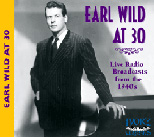Earl Wild’s early career paralleled the golden age of American radio. He served as a staff pianist for NBC between 1937 and 1946, moving over to ABC in 1946. A handful of live broadcast performances from these years survive on transcription discs and reveal a fascinating portrait of this artist as a younger man (pushing 90 in 2004, Wild is merely young!). As you readily hear, the youthful Wild had it all: big tone, immaculate technique, sound musical instincts, and unflappable professionalism. The Scarlatti, Mendelssohn, MacDowell, and Danquin selections were favorite encore-type showpieces of the era, and they stand out for their dry-point clarity and sparkling fingerwork. Chopin’s A-flat Polonaise comes off sounding too fast and glib compared to how the older, more mature Wild would allow more time to characterize the music’s inherent majesty. And while it’s refreshing to hear the two Rachmaninov pieces played absolutely straight, they’re a little too cut-and-dried.
The Liszt Sonata has long been one of Wild’s concert staples, and the 1949 broadcast preserved here provides an interesting gloss upon the pianist’s two studio recordings from the 1970s and ’80s. He effects smooth transitions between the composition’s continuously linked movements and takes plenty of time to let the lyrical D major section (as well as its B major parallel in the recapitulation) unfold without losing its shape. The notorious octave sequences benefit from Wild’s rhythmic discipline, and the central Fughetta builds its way into a powerful, compelling climax. My only quibble concerns how Wild betrays impatience in the work’s brooding sections, suddenly pushing ahead as if he wanted to get them over with, or perhaps he had to pianistically “watch the clock” to comply with broadcast time restraints. For this reason I prefer the fluidity and proportion of Wild’s studio Liszt Sonatas (his 1985 recording also is available from Ivory Classics).
The transfers make every effort to minimize the source material’s limitations. Surface noise is virtually nonexistent, and a tasteful amount of artificial reverberation gives a semblance of body and dimension to what obviously was dry and close-up engineering. This is a fascinating release that surely will appeal to piano mavens curious about Earl Wild’s formative years.
































